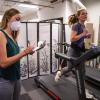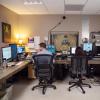Lisa Marshall
 A new first-of-its kind study aims to shed light on why so many people use cannabis before, during or after working out. It also seeks to answer a critical question: Does THC, which is considered a banned substance by the World Anti-doping Agency, hurt or help performance?
A new first-of-its kind study aims to shed light on why so many people use cannabis before, during or after working out. It also seeks to answer a critical question: Does THC, which is considered a banned substance by the World Anti-doping Agency, hurt or help performance? The machine-learning systems that help your phone recommend music, movies, news and more can be biased in ways that leave out artists from underrepresented groups or foster polarization. Professor Robin Burke is working to change that.
The machine-learning systems that help your phone recommend music, movies, news and more can be biased in ways that leave out artists from underrepresented groups or foster polarization. Professor Robin Burke is working to change that. Fifty-five years after a Black postal worker produced the inaugural issue of “The Green Book” to help African Americans navigate a racist society, Black Twitter is playing a similar and even broader role, suggests a new CU Boulder study.
Fifty-five years after a Black postal worker produced the inaugural issue of “The Green Book” to help African Americans navigate a racist society, Black Twitter is playing a similar and even broader role, suggests a new CU Boulder study. A new analysis of 350,000 news stories produced by conservative media giant Sinclair Broadcast Group finds when the company buys a station, local news definitely takes a hit. But it did not find any evidence, at scale, that coverage shifts toward a more conservative slant.
A new analysis of 350,000 news stories produced by conservative media giant Sinclair Broadcast Group finds when the company buys a station, local news definitely takes a hit. But it did not find any evidence, at scale, that coverage shifts toward a more conservative slant. A new, CU Boulder-led study provides strong evidence that a psychological treatment can provide effective and lasting relief for chronic pain, which affects one in five Americans. The treatment also appears to quiet regions of the brain that generate chronic pain.
A new, CU Boulder-led study provides strong evidence that a psychological treatment can provide effective and lasting relief for chronic pain, which affects one in five Americans. The treatment also appears to quiet regions of the brain that generate chronic pain. New research shows that dietary compounds called prebiotics, which serve as food for good bacteria in the gut, make the body more resilient to circadian rhythm disruptions from things like jet lag or shift work.
New research shows that dietary compounds called prebiotics, which serve as food for good bacteria in the gut, make the body more resilient to circadian rhythm disruptions from things like jet lag or shift work. Screen time may not be as harmful as previously suspected for school-aged children and may have some important benefits, according to one of the largest studies to date exlporing how screens impact youth.
Screen time may not be as harmful as previously suspected for school-aged children and may have some important benefits, according to one of the largest studies to date exlporing how screens impact youth. A nationwide abortion ban would lead to a 21% increase in the number of pregnancy-related deaths overall and a 33% increase among Black women, according to new CU Boulder research.
A nationwide abortion ban would lead to a 21% increase in the number of pregnancy-related deaths overall and a 33% increase among Black women, according to new CU Boulder research.
 CU Boulder sleep researchers have found it's possible to determine the timing of a person's internal biological clock via a single blood draw. Ultimately, the findings could lead to personalized recommendations for when people should eat, sleep, exercise and take medications.
CU Boulder sleep researchers have found it's possible to determine the timing of a person's internal biological clock via a single blood draw. Ultimately, the findings could lead to personalized recommendations for when people should eat, sleep, exercise and take medications. A new CU Boulder study shows that rising up out of the saddle and gently swaying the bike side-to-side, known in French as "en danseuse," can significantly boost performance.
A new CU Boulder study shows that rising up out of the saddle and gently swaying the bike side-to-side, known in French as "en danseuse," can significantly boost performance.


